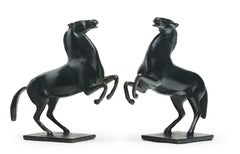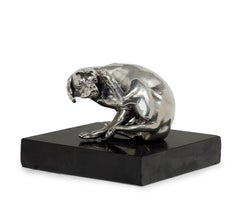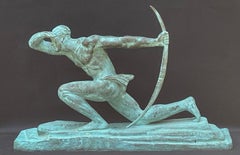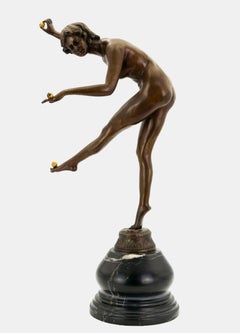Stephane Renard Fine Art Figurative Sculptures
to
2
Overall Width
to
Overall Height
to
1
1
1
1
2
1
1
1
2
1
1
1
1
2
Pair of Prancing Horses, two bronzes signed and numbered by Arno Breker
Located in PARIS, FR
An official artist of the Nazi regime, trained in Montparnasse in the 1930s, Arno Breker continued to sculpt after the fall of the Third Reich, producing large-scale public commissions in Germany and portraits of prominent figures. The two small bronzes presented here, dated around 1978, are part of a long tradition of prancing horses dating back to antiquity. The asymmetrical treatment of the two front legs and the inclination of the head make these two copies of the same artwork a highly decorative pair.
1. Arno Breker, a prolific sculptor, from the Bohemia of Montparnasse to the commissions from the Third Reich ... and from the Federal Republic of Germany
The son of a stone carver, Arno Breker studied fine art and anatomy in his native Elberfeld. At the age of 20, he entered the Düsseldorf Academy of Art. He moved to Paris in 1926, where he continued his training in the studio of Maillol, who dubbed him "the German Michelangelo of the twentieth century". He shared a studio with Alexandre Calder and frequented Jean Cocteau, Foujita, Brancusi, Pablo Picasso and other artists of the bohemian Paris of the time. It was also in Paris in 1933 that he met Demetra Messala, the daughter of a Greek diplomat who posed for Maillol and Picasso, whom he married in 1937. Having won the Prussian Prix de Rome in 1932, he left Paris to stay at the Villa Massimo, the German Academy in Rome.
Returning to Germany in 1934, his style evolved towards a more marked imitation of ancient sculpture. He created two monumental statues for Berlin's Olympic Stadium, before being appointed professor at the Berlin College of Fine Arts in 1937. He came to the attention of the Reich Propaganda Ministry, which awarded him several commissions and provided him with three large studios in which Breker produced many monumental sculptures to the glory of the regime. On June 23, 1940, Breker accompanied Adolf Hitler during a visit to Paris. During the Occupation, his political connections enabled him to intervene on behalf of many artists pursued by the Nazis: for example, he protected Pablo Picasso (then a Communist) from Kommandantur officers.
Most of Arno Breker's work was destroyed in Berlin at the end of the war in 1945 by bombing and intentional destruction perpetrated by soldiers of the victorious powers. After the fall of the Nazi regime, however, Arno Breker was never prosecuted. He opened a new studio in Düsseldorf, where he sculpted until his death in 1991.
He then carried out several public commissions in Germany (Bayreuth, Wuppertal), as well as portraits of numerous personalities, including King Mohammed V of Morocco, Léopold Sedar Senghor (commissioned by the Académie Française in 1978) and the two chancellors of the Federal Republic of Germany, Konrad Adenauer and Ludwig Erhard. The Arno Breker Museum in Nörvenich is now exhibiting some of his artworks.
2. Related artworks: from the Wild Horses of the Quirinal to the Horses of Marly
The prancing horse is a major iconographic theme, found in a series of sculptures from Antiquity, the Renaissance and the Classical Age. Various photos from Arno Breker's studio in Berlin confirm the predominant place of equine representations in his work (alongside male nude statues), and confirm that this reduced version created in 1978 is part of the artist's preferred repertoire.
Prancing horses are generally associated with a male figure in a group that, through a reference drawn from Antiquity, symbolizes man's domination over nature. In this respect, it is very interesting to compare our small bronzes with the horse forming part of a large sculpture by Arno Breker (made in 1936 and probably destroyed in 1945) depicting Alexander taming Bucephalus.
This statue is itself directly inspired by one of the best-known works of 18th-century French sculpture...
Category
1970s Art Deco Figurative Sculptures
Materials
Bronze
Dog scratching its ear
Located in PARIS, FR
This amusing naturalistic sculpture in silver-plated pewter was probably made in the 17th century by Georg Schweigger. Inspired by a model created by another Nuremberg sculptor, Peter Flötner, it bears witness to the persistence during the baroque era of the naturalistic taste that emerged in the Renaissance. Intended as an ornament for some Kunstkammer, or cabinet of curiosities, this sculpture was a great success, as can be seen from the presence of similar works in many European museums.
1. Georg Schweigger
Georg Schweigger was a baroque sculptor and medal founder from Nuremberg, known mainly for his small-scale works in stone, carved wood and cast metal. His only large-scale work, the Neptune Fountain, has been in the Petershof Palace, the summer residence of the Tsars near St. Petersburg, since 1797. This monumental sculpture demonstrates his taste for the representation of movement, which we find in this small piece, inspired, as we shall see, by earlier models.
2. The success of a naturalistic theme
As is often the case in the history of art, the source of the Dog scratching his ear theme probably comes from an engraving, and more precisely from one made in Strasbourg in 1480 or in Aschaffenburg in 1481 by the Master of the Housebook, an anonymous engraver working in southern Germany at the end of the 15th century.
This engraving seems to have been Peter Flötner’s (1490 - 1546) source of inspiration. Peter Flötner was a sculptor and engraver who settled in Nuremberg in 1522. The Louvre Museum also has a gilded lead statuette dated between 1500 and 1515 (on deposit at the Musée de L'Œuvre in Strasbourg), which in turn is thought to have served as a model for other known statuettes.
This model was later taken up by the Frenchman Barthélemy Prieur...
Category
17th Century Naturalistic Figurative Sculptures
Materials
Marble, Silver
$6,324
Related Items
“The Archer”
By Pierre Le Faguays
Located in Southampton, NY
Stunning, original Art Deco bronze of a male archer by the well known French sculptor, Pierre Le Faguays. Condition is very good. Verde green finish over bronze patina. Slight rubbed...
Category
1930s Art Deco Figurative Sculptures
Materials
Bronze
Juggler / - Artistic naturalness -
Located in Berlin, DE
Claire Jeanne Robertine Colinet (1880 Brussels - 1950 Asnières-sur-Seine), Juggler, around 1920. Brownish patinated bronze with gilded balls on a round, multi-profiled stone base (10...
Category
1920s Art Deco Nude Sculptures
Materials
Bronze
$3,428
H 18.51 in W 7.88 in D 9.85 in
Javelin thrower / - Roman present -
By Franz Iffland
Located in Berlin, DE
Franz Iffland (1862 Tempelhof - 1935 Berlin), Javelin thrower, after 1910. Olive-black patinated bronze with cast plinth mounted on a white-veined black marble base (7 cm high). Tota...
Category
1910s Art Deco Nude Sculptures
Materials
Bronze
$2,364 Sale Price
20% Off
H 24.02 in W 10.24 in D 9.85 in
Bellota 7
By María José de la Macorra
Located in Mexico City, CDMX
María José de la Macorra (México, D.F., 1964) realizó sus estudios en la Escuela de Cerámica y Porcelana de Toluca, Mokichi Okada Association,...
Category
2010s Naturalistic Figurative Sculptures
Materials
Bronze
"Mercury" NYC 1931 Bronze 5th Ave Traffic Light Sculpture American Art Deco WPA
Located in New York, NY
"Mercury" NYC 1931 Bronze 5th Ave Traffic Light Sculpture American Art Deco WPA
In the late 1920s, Joseph Freedlander was asked by the City of New York ...
Category
1930s Art Deco Figurative Sculptures
Materials
Bronze
$40,000
H 18 in W 9 in D 6 in
BELLE DE NUIT (SCULPTURE)
By Erté
Located in Aventura, FL
Incised signature by the artist and stamp numbered with foundry and date. Additional images are available upon request. Certificate of Authenticity is included. Please do not hesitat...
Category
1990s Art Deco Figurative Sculptures
Materials
Bronze
Erte CHINCHILLA Sculpture, 21.5"H
By Erte - Romain de Tirtoff
Located in Lake Worth Beach, FL
Artist/Designer; Manufacturer: Erte (Romain de Tirtoff) (Russian/ French, 1892-1990)
Marking(s); notes: signed; ed. 270/375; 1990
Materials: bronze
Dimensions (H, W, D): 21.5"h, 9.25...
Category
20th Century Art Deco Figurative Sculptures
Materials
Bronze
Bronze Spanish naturalistic 19th century sculpture of a young boy
Located in Woodbury, CT
An amazing bronze cast of a little 19th-century boy. The quality of the piece is outstanding, as is the color and patination.
There is little known about the painter other than he wo...
Category
1890s Naturalistic Figurative Sculptures
Materials
Bronze
$2,200 Sale Price
20% Off
H 12 in W 4 in D 4 in
Women with Long Hair and Dress
Located in Houston, TX
Naturalistic figure of a women with long hair and a long dress. The stone is a darker blue toned with natural veins and speckling. The figure is signed on the bottom of the dress.
Category
1980s Naturalistic Figurative Sculptures
Materials
Stone
Kneeling Female Nude, Bronze By Mario Korbel
Located in Norwood, NJ
Joseph Mario Korbel (Czech/American, 1882-1954). Period fine example bronze, dark brown patina, modeled as a nude female kneeling and tying her sandal, raised on a stepped black marb...
Category
Early 20th Century Art Deco Figurative Sculptures
Materials
Marble, Bronze
David Hostetler Female Figurative Sculpture BMW Car Paint Art Deco Commission
By David Hostetler
Located in Nantucket, MA
By Commission. Casting and custom paint will take approximately 4 months. I have to get in line with my paint expert. Cape Lady is a polished bronze casting painted with Glasurit, a hand sprayed car paint. It is BMW white and BMW black. It is a limited edition of 15 with 2 artist proofs. The current edition available would be 6/15. It was cast from an original wood carving by David Hostetler...
Category
2010s Art Deco Figurative Sculptures
Materials
Bronze
Woman and Panther - Bronze by Albert Poncin (1877-1954), Art Deco influence
Located in Gent, VOV
Albert Poncin’s Femme à la Panthère is a striking and elegant Art Deco bronze sculpture that perfectly encapsulates the movement’s characteristic blend of stylized modernity and clas...
Category
20th Century Art Deco Figurative Sculptures
Materials
Bronze
$12,736
H 19.3 in W 6.7 in D 18.12 in



